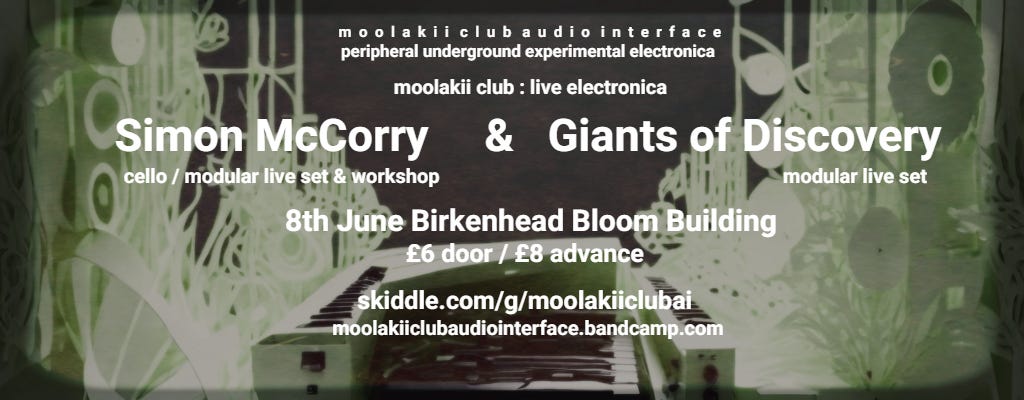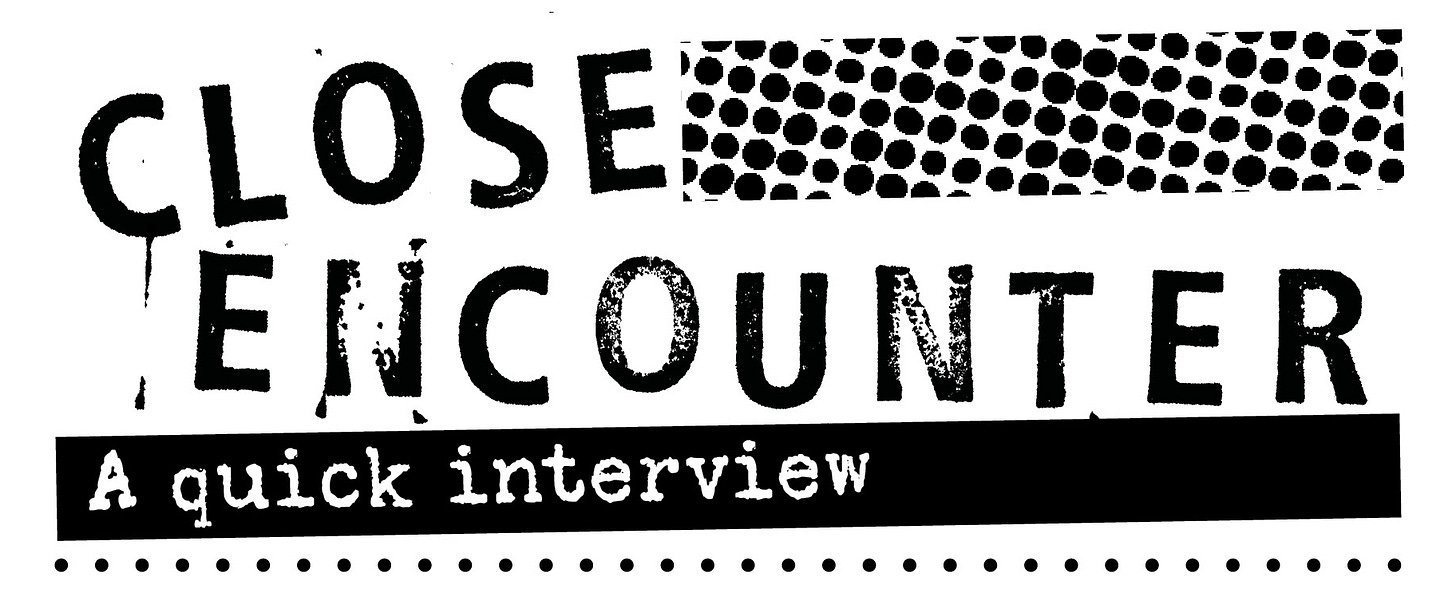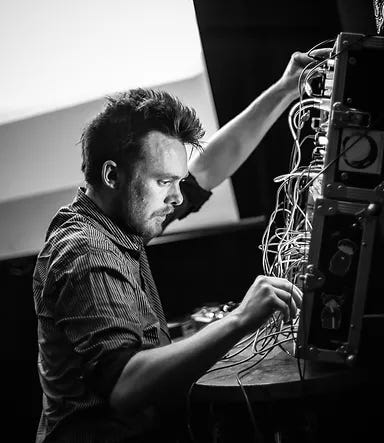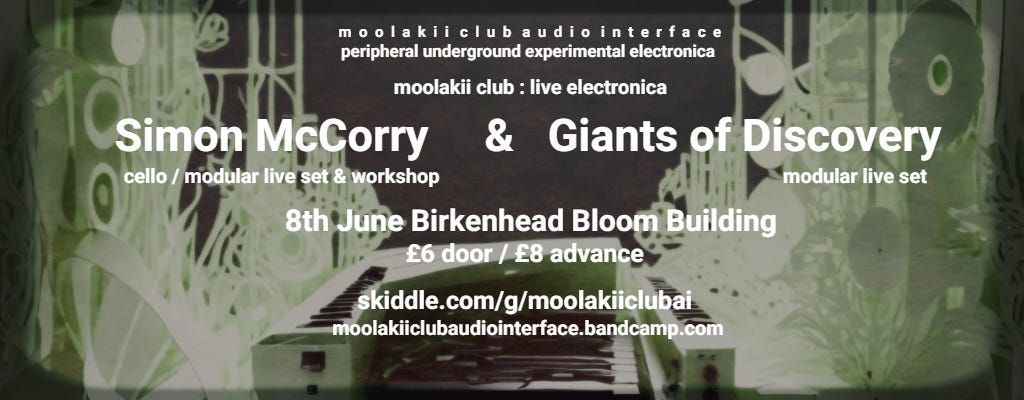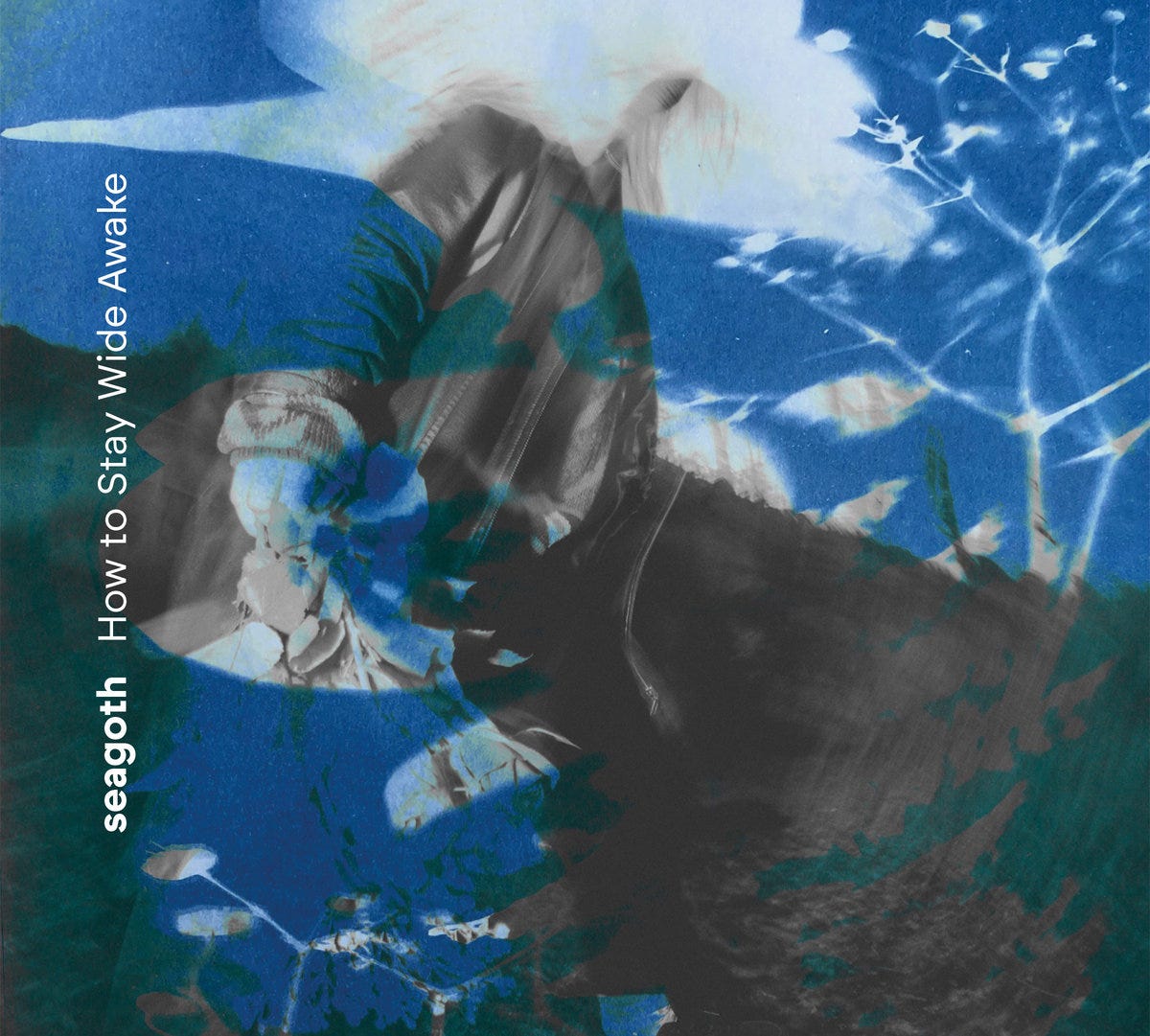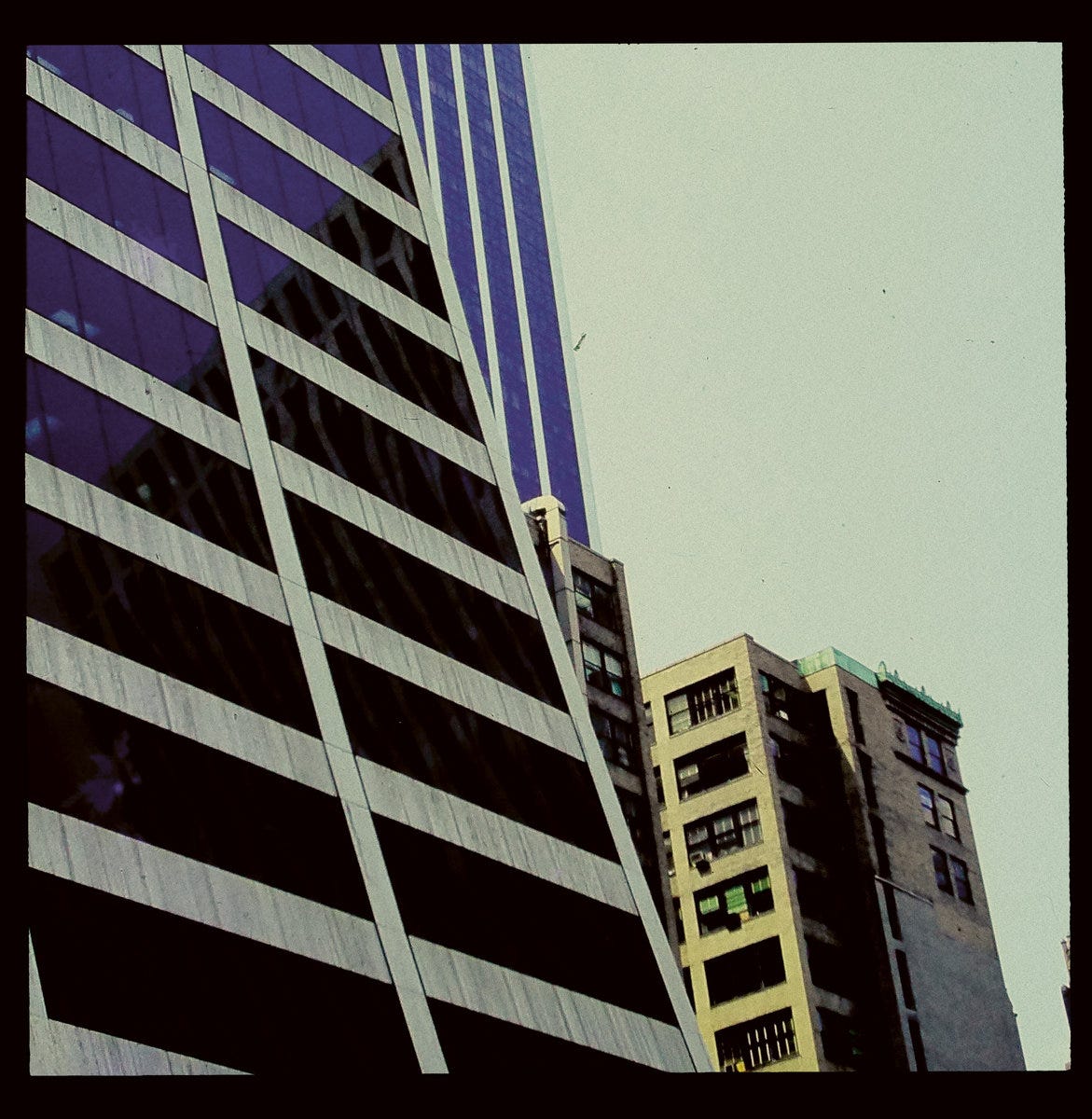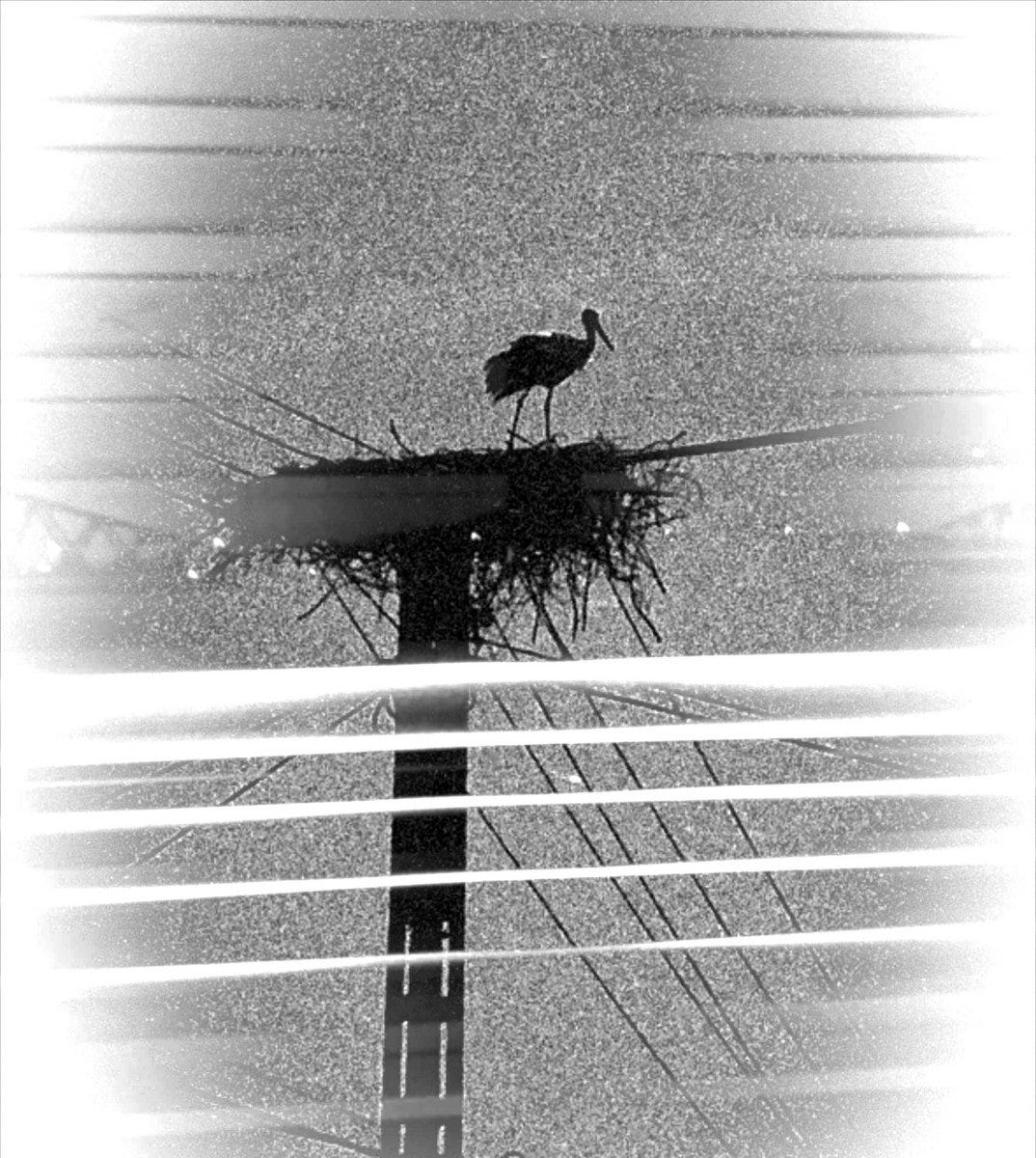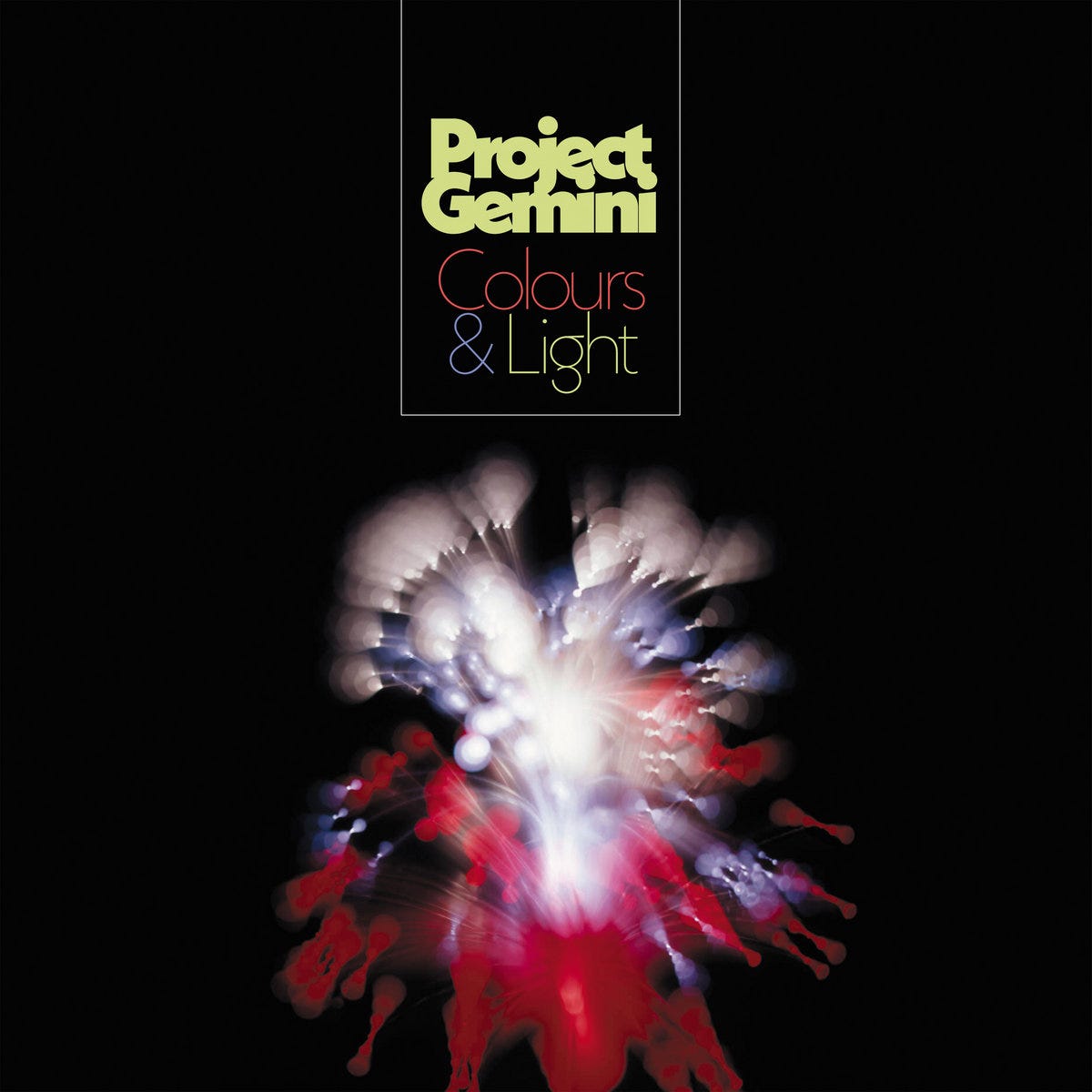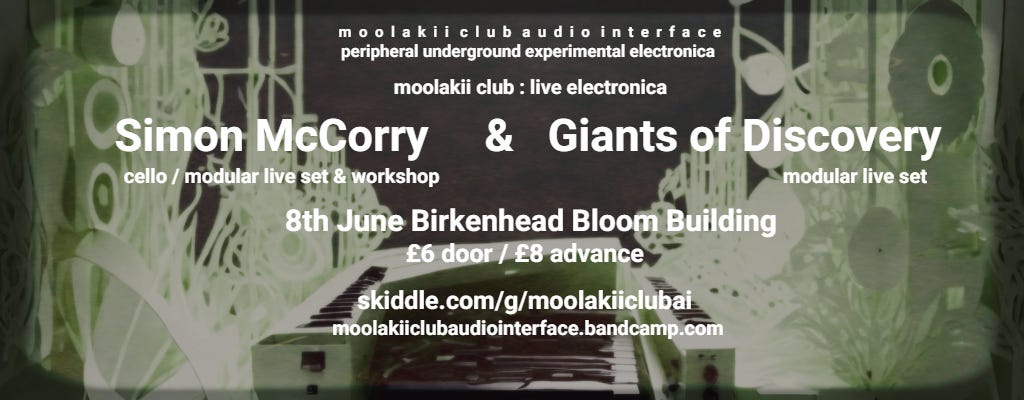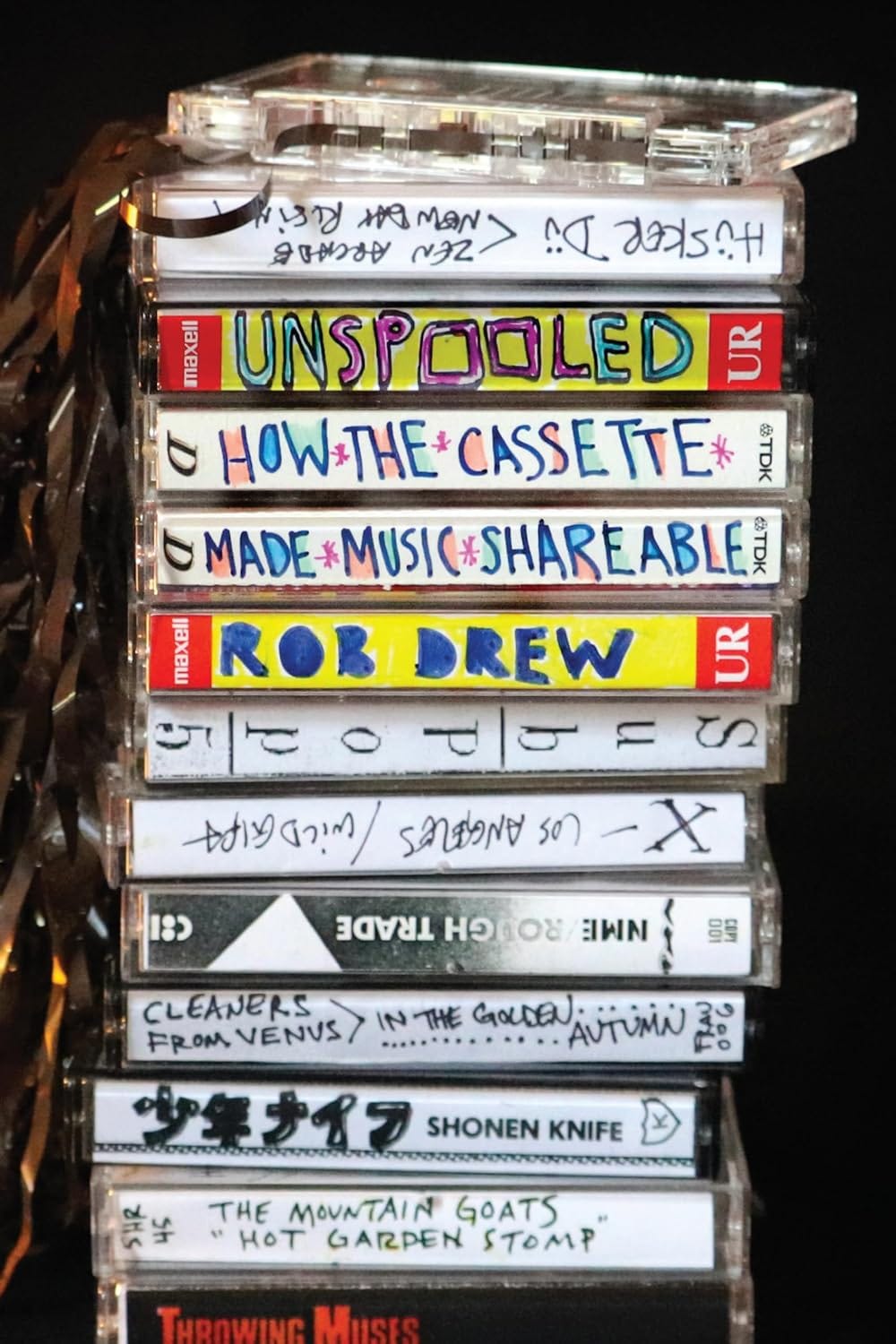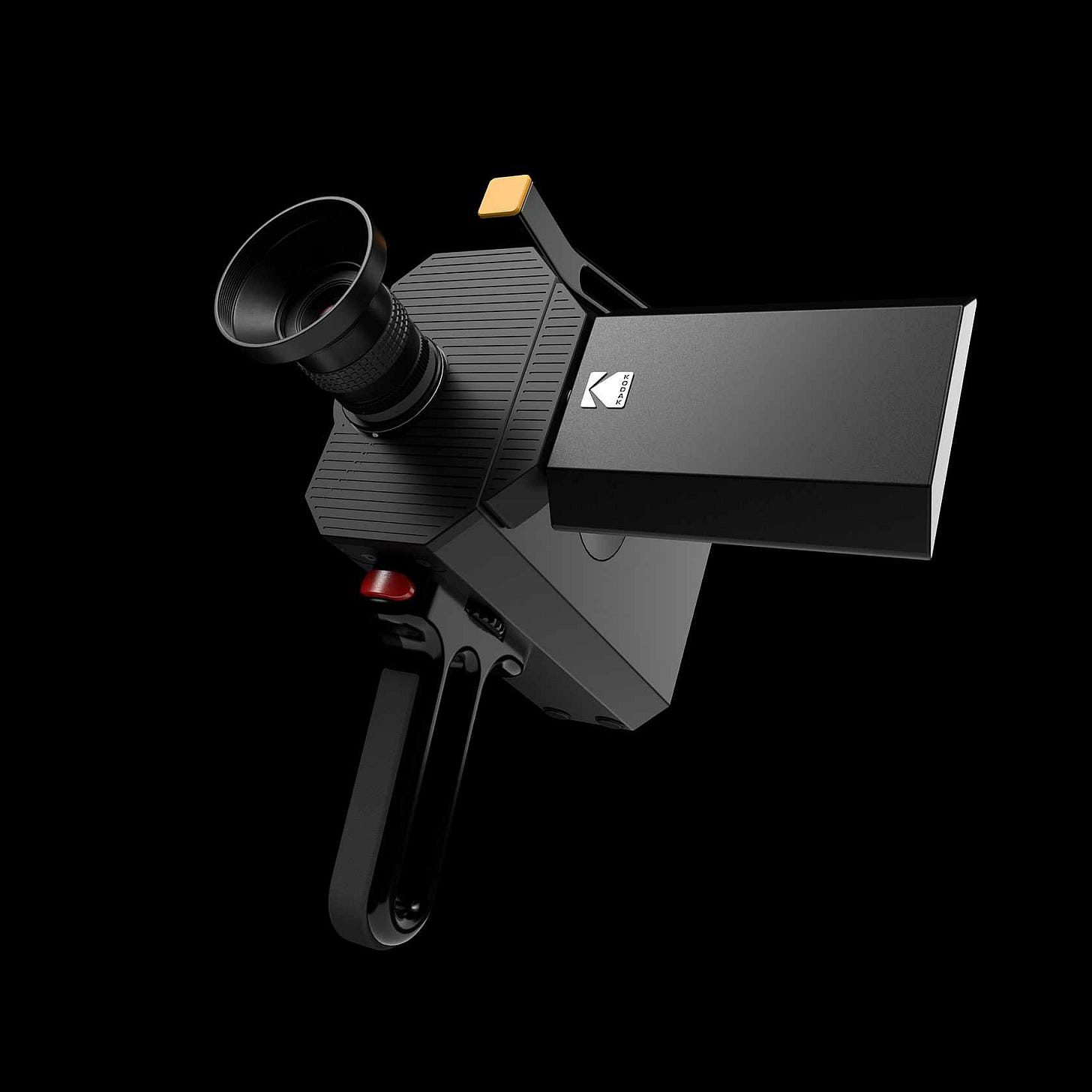Issue 13 / 12 April 2024
This week's DIY electronic goodness... Album Of The Week: Polygone + Difficult Art And Music label chief interview + Track Of The Week: Mark Van Hoen + new release round-up + more...
Oh hello. Happy Friday. Did you catch the bonus newsletter yesterday? We did a Simon Reynolds special to mark the publication of his new book, ‘Futuromania’. Big old review of the book (his first in eight years) and a cracking interview with the man himself. Missed it? It’s right here…
moonbuilding.substack.com/p/simon-reynolds-special-11-april-2024
In other book news, the excellent Matthew Collin, author of ‘Altered State’ and ‘Rave On’, also had a new book out yesterday. ‘Dream Machines – Electronic Music In Britain from Doctor Who To Acid House’ is such a treat. He’s doing a bunch of events in the UK next week – London, Norwich, Leeds and Nottingham – which promise to be excellent. I’ll be hosting the Norwich event on Wednesday if anyone happens to be in the area. Do say hello if you come along. Full details over at omnibuspress.com
Righto. That’s me. I get overtime for all this, right?
Neil Mason, editor
moonbuildingmag@gmail.com
Issue 13 Playlist: bndcmpr.co/bb5ab5ed
Support Moonbuilding: ko-fi.com/moonbuilding
***ADVERTISE HERE***
Email moonbuildingmag@gmail.com for details
POLYGONE ‘Tactics Faculty’ (Difficult Art And Music)
You’ve got to love a good story, and the story behind Polygone’s ‘Tactics Faculty’ is a good story. Formed in 1988, Totnes-based Polygone played hundreds of shows over a period of six years on the Devon free party scene. They were the unit that struck up when the DJs had finished their work for the night. Their sound is described as an “odd brand of mellow, dream-like electronic music” and was a mish-mash of sampled grooves, live instruments, strange noises, drones and “semi-ironic takes on whatever was currently riding the charts, Sinead O’Conner being a particular favorite”. It was ambient Jim, just not as we know it. Indeed, they would seem to have preempted much of what was to come in ambient world from the comfort of a field in the middle of nowhere.
To give you and idea of what they were up to, Brighton’s Difficult Art And Music label have served up a long-lost track from 1991 called ‘Tactics Faculty’. It comes as a boxset that includes a cassette, CD, a booklet telling the band’s story, plus a sticker and an art print. Nice. ‘Tactics Faculty’ clocks in at an impressive 18 minutes and 26 seconds and remains the only 18 minutes and 26 seconds of music Polygone ever recorded. To compliment the track the label has also commissioned a raft of remixes from the likes of Audio Obscura, The Both And, Distant Animals, Phexioenesystems, et al. More of which in a minute.
The story behind all this is real snapshot of a world that seems a million years away. “We played like four gigs a week, for about two years,” the band’s Mark “Danko” Withers told the label. “Sometimes twice a day. Sometimes for four or five hours. And always at the same two fucking farms!”
Devon was awash with dilapidated farms that had huge fields miles from anywhere. What else were the local kids going to do but hold parties in them? The county was already a haven for alternative dropouts, punks and crusties, and places like Totnes were also home to hippies and “space cadets”. That party scene was just waiting to happen.
“Most of us lived at the farms,” continues Mark, “so for a while we’d spend the week getting the site ready, and the weekend throwing the party. Rinse, repeat. Every week, for a good couple of years!”
The label explains that Polygone became notorious for their theatrical live shows. “A shared love of both ‘The Rocky Horror Picture Show’ and Throbbing Gristle saw them incorporating camp, am-dram tendencies”. Tendencies that attracted hundreds of people each weekend. It’s the sort of thing that wouldn’t be lost on the gentrified audiences at Glastonbury’s fringe these days.
So how has all this come to light? That’s down to DAAM’s Daniel Hignell-Tully, an arts researcher and lecturer, who in 2021 came across a set of bootlegs from the legendary 90s rave Dreamscape at a car boot sale in Exeter. In among them was a CD labelled ‘Polygone 91’. Inside the case, a slip of paper that said “Roddy” along with what appeared to be a postcode. Daniel headed to the address, which turned out to be an old farm in Totnes. “Questioning the farmer revealed little,” he says. “It was only as I was about to leave that his son chipped in. ‘Polygone? That was Mark’s band wasn’t it?’.”
Mark was easy to find. “He was still active in the local area,” explains Daniel. “He’d run a vegan café and was doing a bit of printmaking.” Roddy remains illusive. Mark barely remembers him. “Little ginger kid? 15 I reckon. I think he got us all to do something in a shed one time”.
And so here we are, with that recording. It could easily be something that pops up today on any of the plethora of DIY labels that appear in Moonbuilding Weekly. It’s a great listen, starting out with almost ‘Tubular Bells’-like gentle chimes that give way, slowly, to gentle beats and shimmering drones before the whole thing evaporates into weird treated voices and discordant beats, which by the 12-minute mark has built back up into a trancey tune that then slows right up, disappearing entirely again, leaving the spooky voices to fade as shimmering guitar and keys emerge to gently guide us home. You can imagine soaking this up in a quiet corner after a night on the rave.
The remixes only add to the interest. Taking these curious sounds that came to life in a Devon barn 30-odd years ago and breathing new life into them must’ve been an absolute pleasure. Among the highlights are Finlay Wright’s shimmery ‘After The Edge Of Chaos Remix’, Mucha’s bass rumbling ‘Tactical Interpolation’ and Stereo Minus One whose version, ‘Anthropocene’, comes on like a ghost of Polygone. Ruaridh TVO stay closest to the spirit of the original with their rather intense 16-minute weird-out.
You have to love tales like these. They open up such a rich world. And if we’re not opening up those worlds by retelling these stories they will, most likely, be forgotten forever.
‘Tactics Faculty’ is out now on Difficult Art And Music
DANIEL HIGNELL-TULLY
The Distant Animals/Be Kind Cadaver recording artiste and Difficult Art And Music label grand fromage drops into Moonbuilding HQ for chat about his label, the Devon free party scene of the olden days and just how DAAM came to be releasing a long-lost track from one the scene’s house bands…
Interview: Neil Mason
Hello Daniel, how’s things?
”All good! This is the busiest part of my year, I’m an arts researcher and lecturer when not running a label, but I’m just about staying afloat.”
Before we get to the main attraction, let’s talk about your label, Difficult Art And Music… it’s been around since 2021 hasn’t it? Why did you set it up?
”I’d been in academia for years and kept coming up against these fantastic, conceptual projects being created by impossibly talented people, but which didn’t seem to ever breach the gates of whichever university they had been devised in. It was around the Brexit referendum, and I’d been working on a project exploring the language of Brexit as a source of data-sonification. The team had produced several great outputs, including cutting a bunch of lathe-cut records, and they had ended up just sitting on my shelf. So I thought a label dedicated to released such research would at the very least free up some shelf space.”
It releases exactly what its name suggests doesn’t it?
”Sort of. The name is somewhat tongue-in-cheek, because ‘difficult’ is a fairly contingent, subjective term. I know I find many forms of popular music pretty difficult to enjoy, and yet have far more capacity to sit through some avant-garde classical nonsense than most people. For me, difficult tends not to refer to the music itself, but to the concept. I’m interested in work that sits in an interesting cultural place, or is doing something that might be challenging to explain.”
Can you highlight a couple of notable releases, what are your greatest hits?
”The aforementioned ‘Brexshitting’ was our first release, and we’ve done a few comps, notably the ‘Bivouac Of The Avant-Garde’ series. There’s a fairly big degree of musical diversity inherent to the label – we’ve got a horror-synth soundtrack by Warren Rasmussen, Outsider text and collage by Dole Fam, and more obviously academic stuff like Felipe Vaz’s exploration of LaMonte Young.”
The latest release by Polygone caught my eye. They’re a old rave outfit from the Devonshire free party scene, right?
“Yes, they were part of the Devon scene, based in the infamously hippy town, Totnes.”
There’s some serious detective work gone into this release. You came across them via a CD you found at an Exeter car boot sale?
“Part of my day job is arts research, and I am a record collector, so I tend to be fairly good at sniffing out weird snippets of culture. I knew there had been a really strong West Country hippy/crusty scene, and places like Somerset and Bristol have made a huge contribution to punk and rave. One thing that always interested me was the degree to which a scene can have a big local impact, and then completely disappear with seemingly no trace. I grew up in the Bristol punk scene of the late 90s/early 2000s, which was massive and vibrant, but left almost no mark. I knew there had been a free party scene in Devon and Cornwall, and I was aware of some of the farms and squats that had been part of that. I’m always keeping an eye out for any of the remnants of these sort of scenes, and car boot sales, charity shops and record fairs are always good places to discover the odd gem.”
Inside the case was a slip of paper that said “Roddy” and a postcode? The plot thickens! What happened next?
“The actual name and postcode weren’t that exciting in themselves – you’d be surprised how often tapes, CDs and photographs have little details like that on them. It was more where the postcode was. Totnes is a really unique place, and anyone who knows it knows it’s a bit of beacon for weird stuff, so I was hopeful it might lead to something cool, and it did. A farm with a couple of worse for wear Yurts, and the son of the farmer who knew of this band, Polygone, that used to live there.”
While they played hundreds of shows between 1988 and 1995 they didn’t record much. In fact, there was only one session and one track, ‘Tactics Faculty’
“I think the fact they recorded at all is somewhat of a miracle. From what Polygone’s synth and guitar player Mark told me, they had absolutely none of the normal band aspirations to tour or make records. They just happened to have some instruments, and live at the place where the parties were held. I’m not sure they even really saw themselves as a band – more just sort of party hosts that liked to jam a bit.”
I’ve heard a lot of stories like this over the years that are complete fabrications, and yet this appears to be entirely genuine doesn’t it?
“Whenever you come across these things, part of your brain is asking ‘Really?’. But it’s easy to forget how weird and knotty culture was before the internet homogenised everything. There’s loads of stories like this all across the country – it’s like another layer in England’s rich, but really complex folk history.”
You met up with old members of the band? How did you track them down?
“Mark was still active in the local area – he’d run a vegan café and was still doing a bit of printmaking, so he wasn’t that hard to get hold of. I just emailed and asked about the band and he got back to me after a few weeks with a rather lengthy, somewhat surprised message. We arranged a zoom chat and he had all these photos of his free-party days. He was still making music too, and had just got Ableton for the first time a couple of months before. He was pretty sceptical that anyone would be interested in Polygone!”
They finished off their track for your release some 30-odd years after making those original recordings. That must have been a moment?
”It was mainly Mark, I think he sent the recording to another band member, Suzie Brooks, but I’m not sure how interested they were about Polygone’s resurgence. It was Mark’s idea to have a play adding a couple of things, so we ended up with the original stems plus a bunch of new parts to go with them. I don’t think he was trying to finish the tracks, as much as try out a couple of new ideas and mask some stuff that made him cringe.”
You’ve had a bunch of remixes done, tell me a little about those – why get remixes done? How did the other artists respond to the story?
”I’d had trouble releasing EPs before – no one seemed to buy things unless they were an album, and the recording was less than 20 mins long. I put out a message on the DAAM Twitter asking if anyone wanted to remix, and was roundly ignored. A few months later I tried again and the algorithm gods favoured me, as there was suddenly loads of people interested. It was great, most people really took their time, and you can hear it – there’s some really weird diversity in the remixes.”
And then there’s the story about the band’s unofficial leader, Tim Davies. He disappeared over night in 1993 and no one knows where he went to this day
”By the sounds of it, the end of Polygone – they got kicked out of their shared home/farm without warning – was pretty messy. There was a fairly large entourage of people living or staying at the site, and they all just scattered. The way Mark tells it Tim was the person who managed their co-op and after it fell apart he ran off. Only Mark and Suzie still speak.”
The release is a proper artifact – it comes as a boxset with tape, CD, art print and a magazine that details the history of the band. It’s important that artists like this are remembered and reappraised isn’t it?
”Absolutely. I think we like to romanticise the past, but the reality is there are far more artist that didn’t make it than those who did. And it’s not because they weren’t good enough – it can be arbitrary stuff like living in the wrong place, or stopping to have a family, or breaking up before getting to tour, or whatever.”
If you didn’t do this, Polygone would probably have been forgotten wouldn’t they?
”Who knows? I’d like to think that the upshot of their being like a million micro-labels these days is that more of this sort of thing will get a chance to be discovered.”
Any plans for further excursions into the Devon free party scene for you?
”I’ve not found anything else so far, but if anyone is reading this and has some old recordings from back in the day, feel free to get in touch!”
And what about Polygone, any plans for them to reactivate in light of all this? That’d be something wouldn’t it?
“That would be great! Mark was pretty convinced he could reform Polygone for a while, but I don’t think he’s got Suzie onboard yet. But if he manages it they’ll definitely have a home on DAAM. Maybe he’ll manage to track down the others, but a lot of time has passed, so who knows?”
I love stuff like this, anything else along these lines up your sleeve for the label?
“Nothing else of this sort of archival nature, but we’ve got some pretty exciting plans for some print works, a couple of graphic scores, and an exciting new foray into a whole new format of physical music… watch this space!”
For more, head over to difficultartandmusic.bandcamp.com
***ADVERTISE WITH US***
Big ad, little ad, cardboard box - email moonbuildingmag@gmail.com for details
MARK VAN HOEN ‘Insight’ (Dell’Orso)
We mentioned Mark’s excellent ‘Plan For A Miracle’ album when it was released back in Feb. Here he releases a new EP, featuring ‘Insight’ from the album along with three new tracks, which he says “fit in tone” with the lead track. His people say the EP is “faintly reminiscent” of the ambience of Cluster or Neu! and you can hear what they mean. It’s such a peaceful offering, we’ve had it on rotation here this week in the quiet moments. It’s one of those things you pop on and it just shimmers away beautifully in the corner. Current favorite track, with its deep synth swoops and eastern chimes, is ‘Evig Tak’.
Got an upcoming release? We’re all ears. Find us at moonbuildingmag@gmail.com
Words: Neil Mason
GOOD STUFF #1
SEAGOTH ‘How to Stay Wide Awake’ (Bytes)
When people talk about making records in their bedroom, you don’t imagine they mean their actual bedroom. It’s more a metaphor, right? Something low budget… the debut album from Cheshire’s Georgia Ochoa was made in her actual bedroom. There’s a bunch of videos on Facebook where you can see her bed being used as a desk. I guess you’ve gotta work somewhere and when you turn in an album that is chock full of delicious three-minute synthpop songs, you know, like they used to make in the old days, you can work where you flipping well like. Opener ‘Eternity’ with its clattering drums, rumbling bass and soaring guitar solo is the sort of thing you could imagine getting a rousing intro from Janice Long on ‘Top Of The Pops’ back in the mists. I would have loved this as a Smash Hits-reading teen, it just has a sound that resonates – warm, rich melodies, guitars packed with shimmery reverb. And it has a funk to it, kind of reminds me of Lonelady at her most poppy. There’s a bunch of great remixers onboard here too. If a seal of approval were needed GLOK, Minotaur Shock and Maps serve it up. This is cracking stuff.
GOOD STUFF #2
JONATHAN SHARP ‘Divided Time 79’ (Castles In Space)
The Heartwood Institute’s Jonathan Sharp continues his time travel adventure with the second part of his ‘Divided Time’ series. The first, long sold-out offering documented early 70s London, here we jump forward to 1979 when his dad was living and working in New York and a family visit in that summer blew young Jonathan’s mind. “As a 12-year-old who’s only experience of the US was from film and TV, this was a life changing trip,” he offers. “I’d never even been on a plane before.” He recently found some old photos from that summer and says it all came flooding back. “The vast differences in culture. New York’s iconic buildings, the grim state of parts of it. Hot dogs, hamburgers, huge cars. All of this a million miles from the dismal world of Thatcher’s Britain.” It’s a lovely piece of work, all shimmery (word of the week) and glittery. ‘Taxi Driver’ it is not.
GOOD STUFF #3
ANDREW BURGE ‘A Pressure Point In Time’ (Human Geography)
Human Geography seem to be releasing stuff faster than I can write about it lately. Let’s run you through the last three. Top of my pile is Andrew Burge’s ‘A Pressure Point In Time’, two tracks, ‘[I]’ and ‘[II]’, both 7.20 long, both sounding like they capture the buzzing of industrial electricity pylons. In the wind. The artwork pictures a stork (is it a stork?) making a nest on one such pylon. Which is why I probably thought about it. I’m very easily led. Andrew describes it as “soft electronic textures that drift, twist and turn across the horizon”, so you know, I could be right. I like it whatever it is. Also worth a look while you’re on their Bandcamp page is the excellently named Thrill Behind Barks’ ‘A Small Quagmire’ which is “an experimental project based in the twin cities of Minneapolis/St Paul, Minnesota, by the three founding members of dark synth group, The Seven Whores of the Apocalypse”. I mean, that’s worth a listen, right? I like the clank and grind of ‘Time Toy Wobble Trick’. And then from Hadfield-based composer David Curington there’s ‘Textiles’ which experiments with political messaging in a cut-up fashion. It’s very intense. No, you can’t dance to it.
human-geography-recordings.bandcamp.com
GOOD STUFF #4
PROJECT GEMINI ‘Colours & Light’ (Mr Bongo)
A follow-up to 2022’s ‘The Children Of Scorpio’, which makes this the difficult second album for London-based Paul Osborne. Not a whole lot difficult about this to my ears. It has that same cult b-movie vibe of the first outing, something that would probably be at home on a record player in the Ghost Box office. It kind of reminds me a little of the Regal Worm or Cobalt Chapel side projects of I Monster’s Jarrod Gosling. Some people are just supposed to be making music and Paul is one of them. ‘Colours & Light’ is just so light and breezy. His people say it’s “hazy cinematic funk”, which it is especially on the tracks vocalised by the smoky tones of Wendy Martinez, from French psyche outfit Gloria. There’s a ton of guests here – Jack Sharp from Large Plants, Little Barrie’s Barrie Cadogan, a couple of The Soundcarriers and even Paul’s daughter, Olivia on keys.
GOOD STUFF #5
DANA GAVANSKI ‘Late Slap’ (Full Time Hobby)
There’s a few names you like to keep an eye on and when they pop up, not necessarily as the headline artist, you tend to listen. Tunng’s Mike Lindsay is very high on my list. Mike produced previous Moonbuilding Album Of The Weeker William Doyle’s last album and here he shows up with another killer, Dana Gavanski’s ‘Late Slap’. The quality siren was already sounding loudly when I clocked she was on Full Time Hobby. She’s a singer/songwriter on her third album for which she changed her songwriting process and started using Logic. She says, “This helped me build little sound worlds that I wouldn’t otherwise have heard just playing a guitar or the piano”. Does it show? Yup. It’s this really warm sophisticated pop that has just the right amount of quirk, just the right amount to set her a head and shoulder above. Listen to the title track as an example, the plonky piano break, the choral chanting at the end, it’s so good. Oh, keep your eyes out for a solo album from Mike, ‘Mike Lindsay Supershapes Volume 1’, which is due to land in June.
THE ROUND-UP IN A ROUND-UP
I’ve had a right pile-up of releases in the last few weeks. There is so much coming out that I’m carry stuff over from one week to the next and then not having room, or time, or not having room or time, so I’ll try and get through a few now…
Die Partei, a collaborative outing from Tom Dokoupil and Walter Dahn, bridge a gap of 43 years between albums. Their first offering was 1981’s ‘La Freiheit Des Geistes’. I mean, 43 years makes Stereo MCs look like Polypores. Wirtschaftswunder guitarist Dokoupil and former Joseph Beuys student, Dahn, created that first album over the course of a week. Very much rooted in the German new wave, it was packed with charming jazzy-like melodies, samples from TV shows, quirky synth lines and rattling tsk-tsk drum machines. Taking shape over a two-year period, the new outing, ‘Celaviemachinery’ (Bureau B), is much calmer and has a more considered air about it, but it is no less quirky and equally as charming. The label says it features “dreamy landscapes and nods to influential records”. There’s talk of Harald Grosskopf and Tyndall’s second album ‘Traumland’ from 1981, while Dahn reckons ‘Ralf & Florian’ is the most important record in the Kraftwerk catalogue. Lots of German words in there, my spell checker has gone a bit nuts. bureaub.bandcamp.com
Improvised electroacoustic London-based trio Pando Pando are producer/electronic musician Alex Bonney, and two percussionists, Jem Doulton and Will Glaser. That their self-titled debut appears on experimental label Not Applicable is good fit. Arriving at the album following a series of improvised shows where they honed their sound, it says here that it “exceeds the conventions of orthodox jazz”. They’re not kidding. There is something very cool about the meeting of electronics and acoustic instruments, especially drums. Polypores, you may know, was a drummer and he’s expressed an interest in matching up modular synths and live drums. I would love to see that. This is a really curious listen as it veers from the soft tinkles of ‘Waxy Cocoon’ and builds into the rhythmical menace of ‘Fluffy Wires’. Challenging stuff, but you’d expect nothing less from this fine label. not-applicable.bandcamp.com
Shaun Robert is name new to me so I had a dig around, which I always like doing. Turns out he’s based in Bath and has his own label, the brilliantly named Institute For Alien Research. There’s a lot of interesting releases there to get stuck into. He began working with sound with the humble tape recorder “finger poised on the pause button”. And that tape aesthetic remains important as is evident from his work. ‘Spont’ (Wormhole World) is a mix of ambient, field recordings, loops, collage, drone, circuit bending and well, what else have you got? This is a record to get on with the window open and let the two worlds merge. wormholeworld.bandcamp.com
Been enjoying reading Ulrich Krieger’s sleevenotes for his ‘Aphotic III – Bathyal’ on Room40. He says he’s long been fascinated by the “alienness” of oceanic depths. The “Aphotic” zone relates to oceanic depths of between 1,000 and 11,000 metres, and is itself split in three parts – Bathyal, Abyssal and Hadal. These are zones that receive no light whatsoever and as such contain mysteries galore. What is it they say? We know more about outer space than we do about our own oceans. Anyway, Ulrich has been exploring these zones in this musical series, starting in the depths and moving upwards. In part III we’re ascending into the upper most Aphotic zone, the Bathyal. A three-tracker, but each one clocking in at 20 minutes, he really does a number on soundtracking the deep. Excellent stuff. room40.bandcamp.com
Last one for this week, as this is getting silly. It’s a big up to the Canary Island massive as both Resonance, the alias of Javier Pérez Rodríguez, and the label Keroxon (a label and festival) are based in Tenerife. I can think of worse things. Javier talks about ‘Valediction’ bringing together synthesisers, tape recorders and analogue machines in an “enchanting, atmospheric album reminiscent of Eno, Jarre or Vangelis’ space-romantic compositions”. I mean, that’s big boots talk, and there’s a review on Bandcamp that seems rather unkind (where do people get off?), but I really like the quiet moments here. ‘Valediction Part 01’ and Part 06 in particular are rather epic. As I’ve said before but Keroxon is an offshoot of the Discrepant label network, which is well worth exploring. keroxenlabel.bandcamp.com
***ADVERTISE HERE***
Email moonbuildingmag@gmail.com for details
SPOOL PARTY
We’re only just in April and this is the second book this year about the cassette. Like Marc Masters’ ‘High Bias – The Distorted History Of The Cassette Tape’ (North Carolina University Press), Rob Drew’s ‘Unspooled – How the Cassette Made Music Shareable’ (Duke University Press) is a Stateside university press title. I’m increasingly finding myself scouring these academic publishing houses who seem to serving up some excellent niche titles covering topics that very much appeal round here.
Here Rob Drew comes at the subject from the only place you can approach tapes – love. The crux of the matter comes in his intro. “As an avid mix taper myself,” he writes. “I had long wanted to probe the mysteries of how mixtapes were pieced together from the public world of pop music to convey private emotions.”
But the author covers a heck of a lot more than that in ‘Unspooled’ as he charts the history of the cassette from its post-World War II origins right up to independent music’s obsession with the format – and I’m talking old school indie and new school here. There’s a whole load of great stuff about DIY culture, there’s the origin story of Sub Pop, which I didn’t know. The famous label started life as a radio show and zine in Olympia, Washington, in the late 70s called ‘Subterranean Pop’. Inspired by an Australian cassette mag called ‘Fast Forward’, Sub Pop spawned its own cassette mag, where readers sent in demo tapes and the best were collected on a C60, which they sold for five bucks a go. This was July 1981. Over in the UK, there’s the story of how NME served up its ‘C81’ cassette that showcased Rough Trade acts. I remember clipping out the coupons and sending off for that with a postal order for £1.50.
There’s a whole heap about hip hop and the cassette. How can there not be? “Cassettes didn’t play a role in hip hop in the early days,” says DJ Bobbito Garcia. “Cassettes were hip hop.” If you weren’t tuned into the radio stations or at the park jams or parties where this nascent scene was taking shape, you missed out. Unless you could put your hands on a tape. First they were informal bootlegs, but it soon became organised. Grandmaster Flash used to run off tapes of his sets and give them to cab drivers who would play them while driving round the city so advertising his wares to wealthy passengers, while many DJs did the same and sold tapes form the DJ booths to make some extra cash money. It’s great little book and all the richer for the stories it tells.
SUPER SHARP SHOOTER
When I first saw Kodak were launching a new Super 8 camera I had to check it wasn’t an April Fool. In a previous life I was art student, working with the medium of light. Or film, video and photography as you might know it. I used Super 8 extensively. It was cheap as chips and the quality of image was in a world of its own. Because of the small area of film (8mm wide, surprisingly) you got these grainy, but beautifully saturated images. You couldn’t beat Super 8.
The film came in handy cartridges that you’d snap into the camera, each one held 50 feet or three and half minutes of film and processing was included. Once exposed, you popped the cartridge in the pre-supplied envelope, filled out your return address details on the back and popped it in the post. I think postage was even paid. Turnaround wasn’t long, a couple of weeks at most, and there were stories you could get an expedited service if you put a tenner in the envelope.
And then the world went digital and Super 8 was yet another casualty. You can still get the stock, but it’s hellishly expensive and processing is hard to find. And hellishly expensive. You’re looking at £70 for one cart, but hey, processing is included. Gulp.
At a mere $5,495, this new Super 8 camera from Kodak isn’t going to do anything for your pocket other than empty it further. But just look at it will you. It comes with a detachable wide-angle lens and has a c-mount so you can attach lenses of your choice (not included, obvs). It has an onboard sound recorder capturing sound via SD card (in the old days, you could buy film that had a mag strip and recorded audio if the camera had a mic). Like all good film cameras this one also allows over and under crank at 18 and 36 frames a second. Under cranking sees the end results sped up when played back, while over cranking gives you slo-mo when played back. It was half a heart attack shooting over-cranked, 50-feet of film doesn’t last very long at that speed!
The four-inch LCD viewfinder on this new camera is going to be controversial. It’s used to navigate extra features, but you’re also going to see exactly what you’re shooting. The old school cameras were always a bit point and hope. I’m surprised this one doesn’t allow for image capture via SD card too, that would have been a nice, contemporary take. All this seems to coincide with Kodak rolling out a ton of new film stock, there’s five flavours, from the standard outdoor stock (50D, d for “daylight”) to high-speed indoor film (500T, T for “tungsten”) as well as black and white. I just need a lottery win and I can kickstart the old Super 8 habit again.
A MESSAGE FROM THE MOTHERSHIP
SPRING SALE…WHILE STOCKS LAST…SPRING SALE…WHILE STOCKS LAST…
MOONBUILDING ISSUE 4, WAS £10 NOW £5 (+P&P). GRAB YOURS WHILE STOCKS LAST … MOONBUILDING.BANDCAMP.COM
The current issue of MOONBUILDING is full to the gills with the good stuff. On the cover, star-in-the-making Maria Uzor, we profile label-of-the-moment quiet details, there’s an incredible interview with Captain Star creator Steven Appleby, and Ghost Box’s Jim Jupp gets busy with our There’s A First Time For Everything questions.
We review a big pile of releases from labels including Castles In Space, Woodford Halse, Persistence Of Sound, Assai, Ahora, DiN, Werra Foxma, Ghost Box and many more. There’s a column from The Orb’s Alex Paterson and the world-famous Captain Star cartoon strip.
This issue’s CD is ‘The Moonbuilding Miscellany – Volume One’, which is put together by CiS supremo Colin Morrison. It’s a belter featuring tracks from the likes of Lo Five, Lone Bison, Twilight Sequence, Ojn, NCHX and more.
Moonbuilding Weekly is a Castles In Space publication.
Copyright © 2024 Moonbuilding





